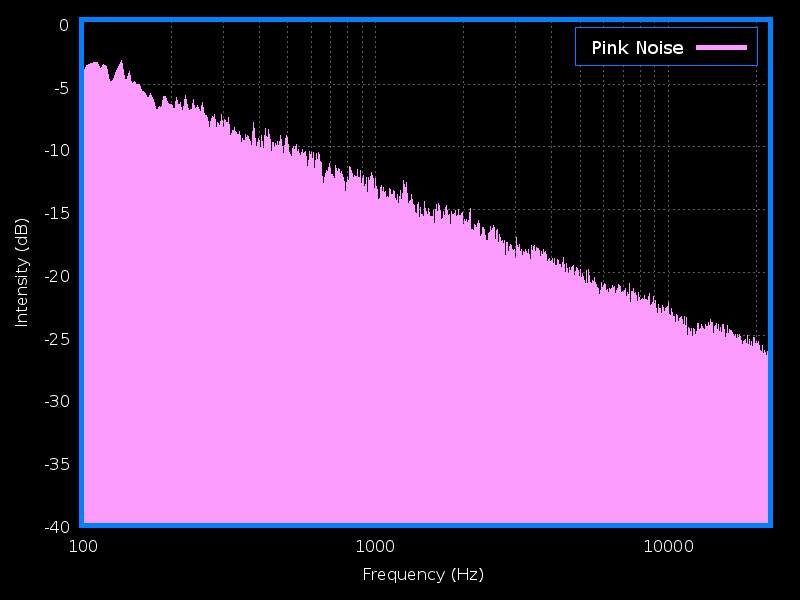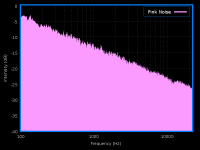Heres the full Fr, top end was cut off in the last pic.
Was this measurement done with 1Watt output power?
Did you still use your cheap USB microphone?
lol Yes! but I do plan on buying something nicer since we talking to you about how I cannot trust the measurements from the u-mic.
I would just add +20dB@20K with digital EQ and it should not be overloaded when I play "music".
Hello Plasnu
I wouldn't do that. Adding a lot of noise and potential power where your distortion is at it's max for a compression driver. Look at the hinge point it's not just a narrow filter it's a coupe of octaves.
Rob 🙂
Last edited:
I think if we look at it from an output power level coming out of the DSP it will give a base level to analyze from...Aiming for a nominal level of input signal (output from the dsp...this is actually technically called gain staging) whether I add or subtract, if I adjust the unity gain back to the neutral level the result will be the same.
That makes sense to me, so between 90-110 db lets call it 100db sensitivity. Covering from 400hz and up I think I'll be aiming somewhere near the max system goal, just shy....

Basically aiming for applicable usage versus sine measurements....
Thats why I think Marks approach is good, it sort of is a middle ground of the natural Fr which rolls off up top vs white noise.
so as long as I am interpreting the above graph correctly....115db system volume will result near 88db at 20khz....and desire 108db (20db headroom) for the headroom allowing peaks to be represented unadulterated.
Ps - As to not confuse anyone new to the concept of Pink noise....Your music is already tailored in way that reflects the pink noise scale so you wouldn't actually tune a system to read flat using pink noise, rather, white noise, which is neutral in power across the spectrum (unless your rta is in 3rd octave mode lol)
That midline sensitivity fulcrum is usually pretty close to measured sensitivity of the integrated flattened passband.
That makes sense to me, so between 90-110 db lets call it 100db sensitivity. Covering from 400hz and up I think I'll be aiming somewhere near the max system goal, just shy....
This is where Plasnu is coming fromexpect to see higher THD at higher frequency when you measure amp/speaker with sine wave sweep.
Basically aiming for applicable usage versus sine measurements....
Thats why I think Marks approach is good, it sort of is a middle ground of the natural Fr which rolls off up top vs white noise.
What I would need is to know how to predict how much headroom per frequency in so many words. I guess I could just look at the pink noise response and add 20db on top of the slope. Also I must consider that this max 115db system volume will reflect a musically play back with a 115db peak likely in the bass region with a slope very close to the Pink Noise as we go up the spectrum.the peak level of actual "music" signal @1K is usually 20dB or more higher than the peak @20K.
so as long as I am interpreting the above graph correctly....115db system volume will result near 88db at 20khz....and desire 108db (20db headroom) for the headroom allowing peaks to be represented unadulterated.
Ps - As to not confuse anyone new to the concept of Pink noise....Your music is already tailored in way that reflects the pink noise scale so you wouldn't actually tune a system to read flat using pink noise, rather, white noise, which is neutral in power across the spectrum (unless your rta is in 3rd octave mode lol)
Attachments
Last edited:
lol Yes! but I do plan on buying something nicer since we talking to you about how I cannot trust the measurements from the u-mic.
Would you please explain how how accomplished exactly 1 Watt into a variable load? What was your measurement setup?
I actually forget how I measured it...its worth doing it again now that you mention it...I should of played a 1khz tone and adjust the voltage to 2.83 and then ran a sweep with the mic at 1 meter....I think thats what I did
---------------------------------------------------------------------------------------------------------
The idea was just shot to me that a quiet enough amp will not add noise if I boost the HF like Plasnu was saying....instead of cutting, to achieve a neutral response and then a lower wattage amp could be used....it would be the same as cutting and then raising unity gain. I would only need a bigger amp if I cut my way to the voicing goal and never touched unity gain.
---------------------------------------------------------------------------------------------------------
The idea was just shot to me that a quiet enough amp will not add noise if I boost the HF like Plasnu was saying....instead of cutting, to achieve a neutral response and then a lower wattage amp could be used....it would be the same as cutting and then raising unity gain. I would only need a bigger amp if I cut my way to the voicing goal and never touched unity gain.
Last edited:
This isn't correct...I need to look at average spl I believeAlso I must consider that this max 115db system volume will reflect a musically play back with a 115db peak likely in the bass region with a slope very close to the Pink Noise as we go up the spectrum.
I just realize that if I am going to aim for a practical amp power, I need to see where spl sits with a 85db averaged spl measurement using pink noise. Looking at the equal loudness contour my guess is something like 105db at 30hz.
Last edited:
lol Yes! but I do plan on buying something nicer since we talking to you about how I cannot trust the measurements from the u-mic.
Why not simply doing two relative measurements withbthe same test setup? One the woofer part and the other the Axi2050 and put them in one diagram?
What I would need is to know how to predict how much headroom per frequency in so many words.
I look at raw response and do the math from there, for each frequency.
Raw response is the key, for assessing potential SPL and headroom, ime.
Whatever EQ's took frequency response to flat really don't matter, when it comes to the driver's real acoustic output/headroom..... per frequency.
As EQ's become a form of gain staging.
Caveats to that 'simple-math headroom extrapolation', are drivers excursion and thermal limits on a per frequency basis.
(of course assuming there are no amp limitations)
I can't take a measurement of the woofer yet....
Mark100, there is no headroom limitations for a driver like this in a domestic situation...right?
Mark100, there is no headroom limitations for a driver like this in a domestic situation...right?
Last edited:
Right, i can't see how you could have headroom problems with the AXI, unless there is simply no loading trying to reach down too low....and you're really crankin 😀
Would you please explain how how accomplished exactly 1 Watt into a variable load? What was your measurement setup?
Hi docali,
Nearly impossible to measure a 1 Watt output...cause like you say it's a variable load.
Most measurement folks mean when talking 1 watt, that they used 2.83 constant volts into an 8 ohm nominal load, or 4V into 2 ohm nominal, etc.
Nominal impedance .......or eyeball average ......is the key...and is what makes wattage specs close to pure bull shite, imo.
ps ...i said nearly impossible because i do know a simple method, based on time averaged measurements
The plan is to play pink noise and monitor voltage, in order to figure out how many watts to aim for. Tomorrow (today)
It's a one step process with direct and easy to see results.AllenB said:Monitor the speaker terminals on your oscilloscope while you listen, to see what an amp needs to do.
Hi docali,
Nearly impossible to measure a 1 Watt output...cause like you say it's a variable load.
Most measurement folks mean when talking 1 watt, that they used 2.83 constant volts into an 8 ohm nominal load, or 4V into 2 ohm nominal, etc.
Nominal impedance .......or eyeball average ......is the key...and is what makes wattage specs close to pure bull shite, imo.
ps ...i said nearly impossible because i do know a simple method, based on time averaged measurements
This is why I asked the question 😉
We cannot find much about constant power amps, either voltage or current drive is used.
I think the most practical way is to choose a fixed resistor with the rated impedance of the driver and adjust the voltage of the amp to 1 Watt.
If you use REW and it's RTA function you can choose periodic Pink Noise and match it in the generator to the number of FFT bins you use in the analyser. That way you will be able to measure flat with pink noise instead of having to revert to white.Ps - As to not confuse anyone new to the concept of Pink noise....Your music is already tailored in way that reflects the pink noise scale so you wouldn't actually tune a system to read flat using pink noise, rather, white noise, which is neutral in power across the spectrum (unless your rta is in 3rd octave mode lol)
Heres the full Fr, top end was cut off in the last pic.
This is the response of the Axi2050 + the plywood tractrix horn?
You baseline sensitivity is around 100dB (400-10k) in this case, and should be slightly higher with the EV horn. You don't need to consider the top octave, because the transmission efficiency is determined by the horn properties (and the extent to which it matches the driver).
Last edited:
The plan is to play pink noise and monitor voltage, in order to figure out how many watts to aim for. Tomorrow (today)
Imo, the 'watts to aim for' is provided by the power spec, which for the AXI is program 300W @ 8 Ohms. I wouldn't use an amp smaller than that, simply to know i have the driver's full headroom available.
I'd put an RMS voltage limiter on the amp, somewhere below the AES rating of 150W. So something below 35V, with attack and release times based off the lower end of freq response.
Peak limiting could be at program rating or even a bit higher. So like 70Vpk, and timings based off high end of freq response.
Oh, hopefully you have a voltmeter that takes time averaged measurements, as pink noise can really bounce around.
If you do, measure the average pink voltage for 30 seconds to a minute, and at the same time take an average SPL measurement. (LZeq in REW.)
If you do that with processing in place, you will get a measured sensitivity of the full integrated passband. A no BS spec.
To make it easier, accept any pink voltage average reasonably close to 2.83V , and whatever distance works,
...and then just use the sengpielaudio calculators to bring it to 2.83V/1m.
(Which is 1W/1m for 8 ohm nominal)
- Home
- Loudspeakers
- Multi-Way
- Is it possible to cover the whole spectrum, high SPL, low distortion with a 2-way?
